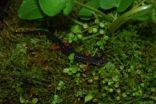(Press-News.org) (MEMPHIS, Tenn. – September 4, 2014) A study led by St. Jude Children's Research Hospital scientists found the avian influenza A H3N8 virus that killed harbor seals along the New England coast can spread through respiratory droplets and poses a threat to humans. The research appears in the current issue of the scientific journal Nature Communications.
The avian H3N8 virus was isolated by scientists investigating the 2011 deaths of more than 160 harbor seals. Researchers discovered the virus had naturally acquired mutations in a key protein that previous laboratory research had shown allowed the highly pathogenic avian H5N1 virus to spread though respiratory droplets. Scientists reported that the avian H3N8 seal virus infected and grew in human lung cells. Researchers also found that the virus spread in ferrets though respiratory transmission, which is uncommon for avian flu viruses and raises concerns about possible person-to-person airborne spread of the harbor seal virus. Investigators found no evidence of human immunity to the strain.
"This study highlights a gain-of-function experiment that occurred in nature and shows us there are avian flu viruses out there beyond H5N1 and H7N9 that could pose a threat to humans," said corresponding author Stacey Schultz-Cherry, Ph.D., a member of the St. Jude Department of Infectious Diseases. In recent years, human cases of highly pathogenic avian H5N1 and H7N9 flu have been confirmed in countries around the world, with mortality rates approaching 60 percent.
"Avian H3N8 viruses are established in horses and dogs. This study raises a red flag about the threat this strain poses to humans exposed to animals infected with the virus," Schultz-Cherry said. While no human illness was linked to the 2011 harbor seal virus, a different flu virus has spread from infected seals to humans who came in close contact with the animals. Avian H3N8 is also believed to have triggered a human flu pandemic in the 1880s.
The findings reinforce the need for continued surveillance of flu viruses circulating in wild and domestic animals to understand the risk the viruses pose to humans, said the study's first author Erik Karlsson, Ph.D., a St. Jude postdoctoral fellow.
The H3N8 harbor seal virus caught the attention of researchers when sequencing showed the virus included two particular mutations in the hemagglutinin (HA) protein and a change in the PB2 gene. HA is carried on the surface of the flu virus. The virus depends on HA to bind to and infect cells. The PB2 mutation was associated with more severe illness in mice. The HA and PB2 changes were among a handful of genetic alterations that in 2012 other scientists reported were sufficient to allow the highly pathogenic H5N1 to spread in ferrets via respiratory droplets.
In this study, two of the three animals exposed to the harbor seal virus via respiratory transmission became infected, although symptoms were mild. Airborne transmission did not occur with the five other avian viruses tested, but two of the viruses spread in ferrets that shared cages. Both viruses were close genetic relatives of the harbor seal virus. Scientists want to understand the genetic changes that make respiratory transmission of avian H3N8 virus possible and the likelihood that related flu viruses will or have acquired those alterations.
Researchers also checked blood samples from 102 individuals vaccinated against seasonal flu strains between 2009 and 2011, including the human H3N2 flu strain. There was no evidence that seasonal flu vaccines protected against the harbor seal virus. "The transmissibility of the seal H3N8 virus coupled with the apparent lack of immunity makes this strain a concern," researchers noted.
INFORMATION:
The study's other St. Jude authors are Richard Webby and Sun Woo Yoon and Jordan Johnson, both formerly of St. Jude. The other authors are Hon S Ip and Jeffrey Hall, of the U.S. Geological Survey (USGS), National Wildlife Health Center, Madison, Wis., and Melinda Beck of the University of North Carolina, Chapel Hill.
The study was funded in part by contracts (N266200700005C, N266200700007C and N272201400006C) from the National Institutes of Allergy and Infectious Diseases, which is part of the National Institutes of Health (NIH); grants (AI078090 and DK056350) from NIH; USGS and ALSAC.
St. Jude Media Relations Contacts
Carrie Strehlau
Desk: (901) 595-2295
Cell: (901) 297-9875
carrie.strehlau@stjude.org
Summer Freeman
Desk: (901) 595-3061
Cell: (901) 297-9861
summer.freeman@stjude.org
St. Jude Children's Research Hospital
St. Jude Children's Research Hospital is leading the way the world understands, treats and cures childhood cancer and other life-threatening diseases. It is the only National Cancer Institute-designated Comprehensive Cancer Center devoted solely to children. Treatments developed at St. Jude have helped push the overall childhood cancer survival rate from 20 percent to 80 percent since the hospital opened more than 50 years ago. St. Jude is working to increase the overall survival rate for childhood cancer to 90 percent in the next decade. St. Jude freely shares the breakthroughs it makes, and every child saved at St. Jude means doctors and scientists worldwide can use that knowledge to save thousands more children. Families never receive a bill from St. Jude for treatment, travel, housing and food—because all a family should worry about is helping their child live. To learn more, visit stjude.org or follow St. Jude at @stjuderesearch.
Avian influenza virus isolated in harbor seals poses a threat to humans
St. Jude Children's Research Hospital-led study found naturally acquired mutations in the avian H3N8 flu virus allow the infection to spread in mammals via respiratory droplets; human immunity to the virus is lacking
2014-09-04
ELSE PRESS RELEASES FROM THIS DATE:
2-D or 3-D? That is the question
2014-09-04
The increased visual realism of 3-D films is believed to offer viewers a more vivid and lifelike experience—more thrilling and intense than 2-D because it more closely approximates real life. However, psychology researchers at the University of Utah, among those who use film clips routinely in the lab to study patients' emotional conditions, have found that there is no significant difference between the two formats. The results were published recently in PLOS ONE.
The study aimed to validate the effectiveness of 3-D film, a newer technology, as compared to 2-D film that ...
Team identifies important regulators of immune cell response
2014-09-04
JUPITER, FL, September 4, 2014 - In a collaborative study, scientists from the Florida campus of The Scripps Research Institute (TSRI) and the La Jolla Institute for Allergy and Immunology have developed a more effective method to determine how immune cells called T cells differentiate into specialized types of cells that help eradicate infected cells and assist other immune cells during infection.
The new approach, published recently by the journal Immunity, could help accelerate laboratory research and the development of potential therapeutics, including vaccines. The ...
Knowing how bacteria take out trash could lead to new antibiotics
2014-09-04
AMHERST, Mass. – A collaborative team of scientists including biochemist Peter Chien at the University of Massachusetts Amherst has reconstructed how bacteria tightly control their growth and division, a process known as the cell cycle, by specifically destroying key proteins through regulated protein degradation.
Regulated protein degradation uses specific enzymes called energy dependent proteases to selective destroy certain targets. Because regulated protein degradation is critical for bacterial virulence and invasion, understanding how these proteases function should ...
Reacting to personal setbacks: Do you bounce back or give up?
2014-09-04
Sometimes when people get upsetting news – such as a failing exam grade or a negative job review – they decide instantly to do better the next time. In other situations that are equally disappointing, the same people may feel inclined to just give up.
How can similar setbacks produce such different reactions? It may come down to how much control we feel we have over what happened, according to new research from Rutgers University-Newark.
The study, published in the journal Neuron, also finds that when these setbacks occur, the level of control we perceive may even determine ...
Plant-based research at Penn prevents complication of hemophilia treatment in mice
2014-09-04
While healthy people have proteins in their blood called clotting factors that act quickly to plug wounds, hemophiliacs lack these proteins, making even minor bleeds difficult to stop.
The main treatment option for people with severe hemophilia is to receive regular infusions of clotting factor. But 20 to 30 percent of people who get these infusions develop antibodies, called inhibitors, against the clotting factor. Once these inhibitors develop, it can be very difficult to treat or prevent future bleeding episodes.
In a new study, researchers from the University of ...
LSU Health research discovers new therapeutic target for diabetic wound healing
2014-09-04
New Orleans, LA – Research led by scientists in Dr. Song Hong's group at LSU Health New Orleans has identified a novel family of chemical mediators that rescue the reparative functions of macrophages (a main type of mature white blood cells) impaired by diabetes, restoring their ability to resolve inflammation and heal wounds. The research is in-press and is scheduled to be published in the October 23, 2014 issue of Chemistry & Biology, a Cell Press journal.
The white blood cells, or leukocytes, of the immune system, help defend the body against infection or foreign ...
Study shows complexities of reducing HIV rates in Russia
2014-09-04
(Boston) – Results of a new study conducted in St. Petersburg, Russia, show that decreasing HIV transmission among Russian HIV-infected drinkers will require creative and innovative approaches.
While new HIV infections globally have declined, HIV rates remain high in Russia. This is due in large part to injection drug use and spread via heterosexual sex transmission. Alcohol use also has been shown to be related to risky sexual behaviors and sexually transmitted infections (STIs).
Published online in Addiction, the study showed that a behavioral intervention did not ...
AGU: Ozone pollution in India kills enough crops to feed 94 million in poverty
2014-09-04
WASHINGTON, D.C. – In one year, India's ozone pollution damaged millions of tons of the country's major crops, causing losses of more than a billion dollars and destroying enough food to feed tens of millions of people living below the poverty line.
These are findings /of a new study that looked at the agricultural effects in 2005 of high concentrations of ground-level ozone, a plant-damaging pollutant formed by emissions from vehicles, cooking stoves and other sources. Able to acquire accurate crop production data for 2005, the study's authors chose it as a year representative ...
Greener neighborhoods lead to better birth outcomes, new research shows
2014-09-04
CORVALLIS, Ore. – Mothers who live in neighborhoods with plenty of grass, trees or other green vegetation are more likely to deliver at full term and their babies are born at higher weights, compared to mothers who live in urban areas that aren't as green, a new study shows.
The findings held up even when results were adjusted for factors such as neighborhood income, exposure to air pollution, noise, and neighborhood walkability, according to researchers at Oregon State University and the University of British Columbia.
"This was a surprise," said Perry Hystad, an environmental ...
Scientists prove ground and tree salamanders have same diets
2014-09-04
Salamanders spend the vast majority of their lives below ground and surface only for short periods of time and usually only on wet nights. When they do emerge, salamanders can be spotted not only on forest floors but also up in trees and on other vegetation, often climbing as high as 8 feet. Given their infrequent appearances aboveground, it has never been clear to biologists why salamanders take time to climb vegetation. Researchers at the University of Missouri recently conducted a study testing a long-standing hypothesis that salamanders might climb vegetation for food. ...
LAST 30 PRESS RELEASES:
Decoupling the HOR enhancement on PtRu: Dynamically matching interfacial water to reaction coordinates
Sulfur isn’t poisonous when it synergistically acts with phosphine in olefins hydroformylation
URI researchers uncover molecular mechanisms behind speciation in corals
Chitin based carbon aerogel offers a cleaner way to store thermal energy
Tracing hidden sources of nitrate pollution in rapidly changing rural urban landscapes
Viruses on plastic pollution may quietly accelerate the spread of antibiotic resistance
Three UH Rainbow Babies & Children’s faculty elected to prestigious American Pediatric Society
Tunnel resilience models unveiled to aid post-earthquake recovery
Satellite communication systems: the future of 5G/6G connectivity
Space computing power networks: a new frontier for satellite technologies
Experiments advance potential of protein that makes hydrogen sulfide as a therapeutic target for Alzheimer’s disease
Examining private equity’s role in fertility care
Current Molecular Pharmacology achieves a landmark: real-time CiteScore advances to 7.2
Skeletal muscle epigenetic clocks developed using postmortem tissue from an Asian population
Estimating unemployment rates with social media data
Climate policies can backfire by eroding “green” values, study finds
Too much screen time too soon? A*STAR study links infant screen exposure to brain changes and teen anxiety
Global psychiatry mourns Professor Dan Stein, visionary who transformed mental health science across Africa and beyond
KIST develops eco-friendly palladium recovery technology to safeguard resource security
Statins significantly reduce mortality risk for adults with diabetes, regardless of cardiovascular risk
Brain immune cells may drive more damage in females than males with Alzheimer’s
Evidence-based recommendations empower clinicians to manage epilepsy in pregnancy
Fungus turns bark beetles’ defenses against them
There are new antivirals being tested for herpesviruses. Scientists now know how they work
CDI scientist, colleagues author review of global burden of fungus Candida auris
How does stroke influence speech comprehension?
B cells transiently unlock their plasticity, risking lymphoma development
Advanced AI dodel predicts spoken language outcomes in deaf children after cochlear implants
Multimodal imaging-based cerebral blood flow prediction model development in simulated microgravity
Accelerated streaming subgraph matching framework is faster, more robust, and scalable
[Press-News.org] Avian influenza virus isolated in harbor seals poses a threat to humansSt. Jude Children's Research Hospital-led study found naturally acquired mutations in the avian H3N8 flu virus allow the infection to spread in mammals via respiratory droplets; human immunity to the virus is lacking




